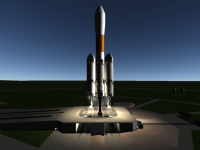

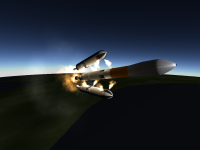
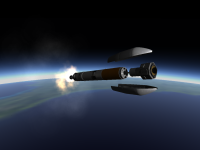
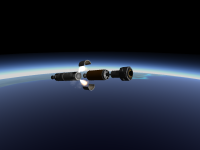

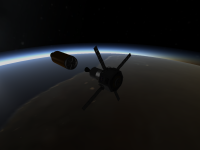
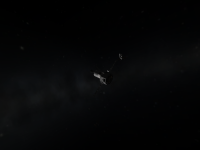
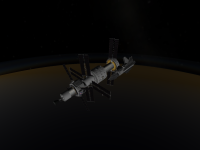
TLF-2 was a manned lunar orbit using the Delta Taxi (callsign "Sojourner") in conjunction with the Napier 1 spaceplane (mission NTF-9). The multiple-launch architecture also involved a CDEDS and made use of the recently-launched Legendre Space Station in LEO at 400km/28.6°, as well as the Lebesgue Propellant Depot in LLO.
This 'B-class' lunar mission followed the 'A-class' TLF-1 flyby of eight months earlier. Although we had to stretch a few vehicles as compared to TLF-1, the biggest launch only rose to 284t GLOM.

CONOPS diagram for this B-class lunar orbit mission.
The Delta Taxi "Sojourner", a one-man spaceship with 4,000m/s of ΔV (through its AJ10-138 ERPS) and no atmosphere capability, launched on the 10th of September 1964, atop a Leibnitz DE6. This is similar to the ’DE5 that launched Wayfarer, but with minor adjustments for the heavier payload — Sojourner has slightly more propellant as it needs to make both TEI and ERB burns on the same (post-refuelling) propellant load. While we could have launched it short-fuelled (pre-refuelling it only needs the 3.2km/s for ERB on a free-return abort), going for full tanks remains within the capability of our LVs and means that less propellant from the Lebesgue depot is consumed.
 |
 |
 |
| Lift-off of Leibnitz DE6 | Passing through Max-Q | Dropping the H-1 boosters |
 |
 |
 |
| Fairing separation | Dropping the sustainer | Centaur burn |
 |
 |
 |
| Deploying the payload | Arriving at the Station | Docked with Legendre |
Napier 1, a two-man spaceplane with 2km/s of orbital insertion/manœuvring capability from its XLR81-BA-13 engine, launched for the thirteenth time at 1001Z on October 8th, 1964, on the Leibnitz DH11 booster. This is essentially the same as the ’DH8 that made the corresponding launch on TLF-1.
The crew of the Napier were Peter Chapman (pilot) and Rebecca Reid (passenger). This is both astronauts' second spaceflight; their first was NTF-5 which took Rebecca to meet Taxi "Quester" for TPF-1, an earth-orbital shakedown of the Taxi design.
CDEDS 2 launched atop Euler A*8 on the 9th of October 1964. The Euler and CDEDS were substantially the same as those used in TLF-1, but with a small stretch to accomodate the greater Taxi mass.
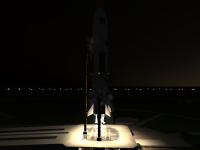 |
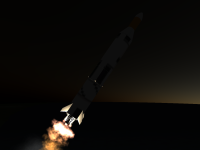 |
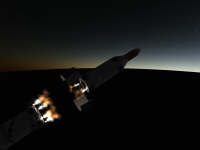 |
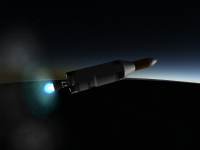 |
| Lift-off of Euler A*8 | Maximum dynamic pressure | Volta burnout and staging | Eulerian carries on |
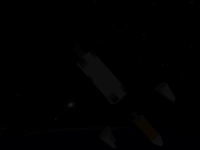 |
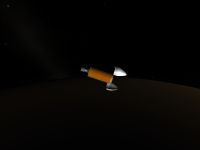 |
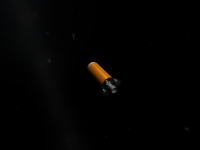 |
|
| Separating the payload | Deploying the fairings | Rendezvous with Station |
The CDEDS arrived at Legendre Space Station later on the 9th (7 hours after launch), at which point Rebecca Reid undocked Sojourner from the Station and flew to meet the CDEDS. The 3.1km/s trans-lunar injection burn followed some 1¼ hours later; the initial acceleration was 0.54g and even by shutdown this had only reached 1.09g; the burn lasted for just over seven minutes. As before, the cabin was oriented 'upside-down' during TLI.
A couple of hours later, after a small TCM on the last of its RCS, we jettisoned the empty CDEDS.
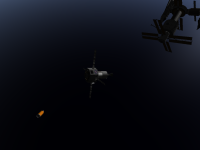 |
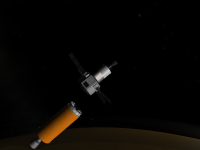 |
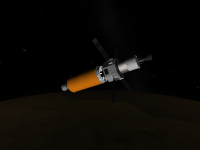 |
| Taxi departs from Legendre | Approaching the CDEDS | Docked |
 |
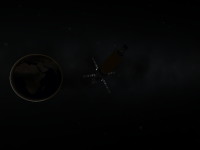 |
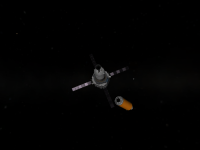 |
| Making TLI burn | In Earth's shadow | Jettisoning CDEDS |
For almost three days, Sojourner coasted across the vast dark emptiness, before noticing the moon's pull 71 hours after TLI. For the next 17½ hours the Taxi fell towards a 102km periselene.
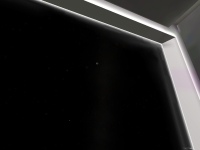 |
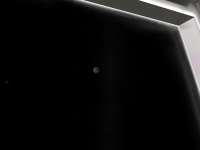 |
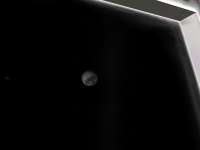 |
| The Moon, far | The Moon, less far | Getting closer |
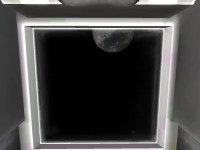 |
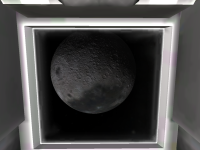 |
|
| Into lunar SOI | Almost there |
In what can only be attributed to extraordinary good fortune, the timing of our periselene was almost perfect in that we were only 12km away from Lebesgue as we lit up for LOI. The 824m/s burn took 99 seconds and ran from 0.75g to 0.98g. After a series of small orbital manœuvres, Sojourner arrived at Lebesgue two hours later, though docking had to wait half an hour for the sun to rise.
Sojourner remained in lunar orbit for 23 hours 10 minutes, of which 17h28m was spent attached to Lebesgue.
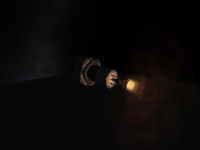 |
 |
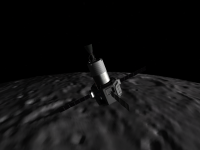 |
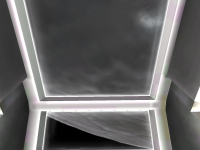 |
| Lunar orbit insertion | Craters close up | In phasing orbit | A grey expanse |
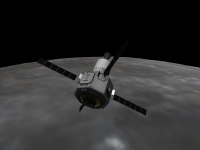 |
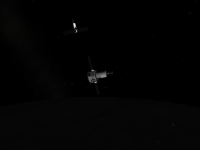 |
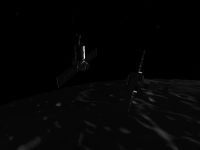 |
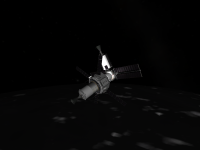 |
| Yes, there's still a moon here | Rendezvous with Lebesgue Depot | Lining up to dock | Docked and refuelling |
A 100-second burn by the AJ10-138 engine gave Sojourner the 829m/s of TEI. The 3½ day return journey left rather thin margins in the life support system; a day in lunar orbit is just about the limit for B-class missions. Rebecca ran out of foodpaste tubes a couple of hours before perigee, and the oxygen tank levels were getting worryingly low…
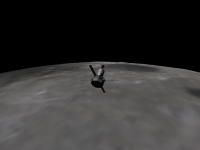 |
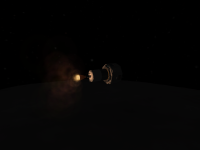 |
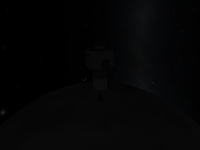 |
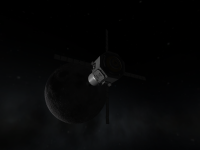 |
| Leaving Lebesgue behind | Trans-Earth Insertion | We're going home | Goodbye, moon! |
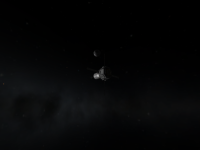 |
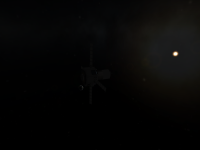 |
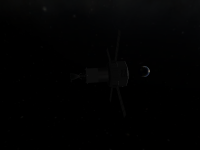 |
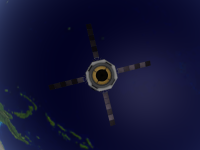 |
| Moon looks small now | But so does Earth | A bit bigger now | Suddenly we're back |
Late on the 17th (at 2330Z), Sojourner made a 2,718m/s braking burn with the ERPS. This time the orbital positions weren't favourable and significant phasing was needed to reach a rendezvous. With the life-support clock ticking, we decided to undock Napier from Lebesgue and make orbital manœuvres to get to Sojourner quicker than the Taxi could reach the Station. Cue a series of not always well-thought-out burns as we scrambled to make rendezvous before the oxygen ran out. We finally got there at 0314Z on October 18th, with just 33 minutes' life-support margin.
(I didn't take many screenshots because I was busy fiddling with manœuvre plans and panicking about margins.)
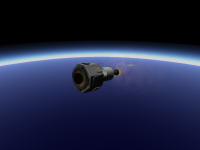 |
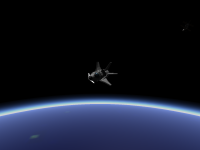 |
| Earth Return Braking burn | Napier leaving the station |
With Rebecca safely aboard the Napier, we had just enough HTP left to de-orbit on RCS, with an 80km perigee (and a 660km apogee, making for a rather faster than normal re-entry). Peter guided the spaceplane down, from the Kármán line at 0430Z to the Earth's surface at 0508Z with a peak acceleration of 1.41g. Owing to the orbital eccentricity and low propellant state, we were unable to select the re-entry location; thus Napier 1 splashed down in the south Pacific, a little way north of New Zealand.
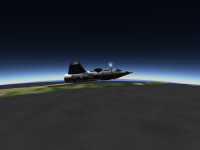 |
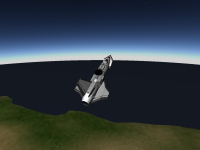 |
 |
| Napier crosses the Kármán line | Aerobraking over Australia | Airliner-smooth descent |
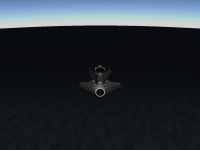 |
 |
|
| Gradually coming down | Low over the Pacific |
Acknowledging that we ran dangerously close to the Delta Taxi's limits on both life-support and ΔV, we will not re-fly the B-class mission. Instead we will develop an improved Taxi (with at least another 200m/s for margins) and move on to the C-class mission, with a life-support resupply at Lebesgue. Elsewhere in the Solar System, Brian Newman and scientist-astronaut Yefim Obolensky are about to pass the 90-day mark at Legendre Space Station, Copernicus 6 in Jupiter orbit is preparing to attempt a fly-by of Europa, and we're stacking Galvani B1 to send a lander probe to Mars.